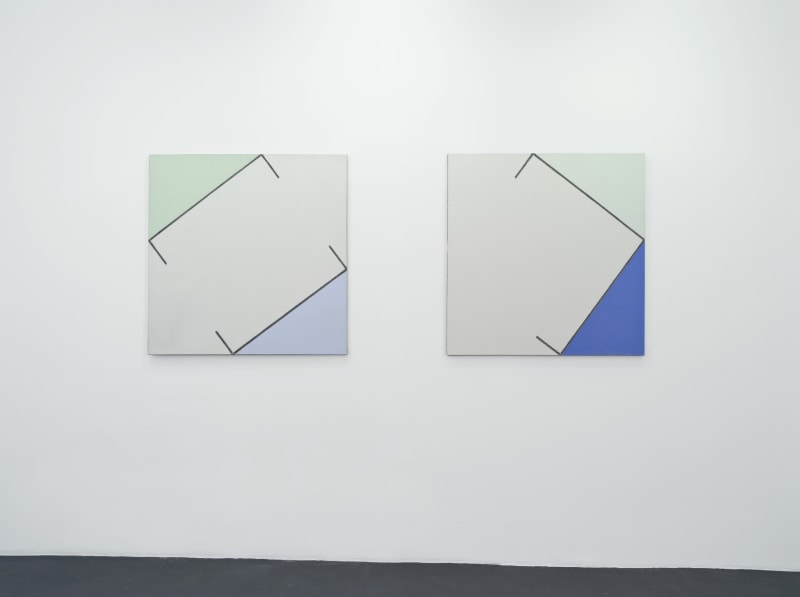Under the auspices of the Palais de Tokyo’s summer program “Nouvelles Vagues” Galerie Nathalie Obadia is pleased to announce the first exhibition devoted exclusively to the paintings of Martin Barré and R.H. Quaytman.
Martin Barré, a major figure in the history of postwar French abstraction, and R.H Quaytman, an American artist pivotal in the current resurgence of conceptual painting, use systems of proportion to create paintings as well as to install them. Rebelling against the classical ideal of compositional balance, their goal is to simultaneously establish a pictorial order and to destroy it. R.H Quaytman writes: “I seek to maintain and simultaneously disrupt painting’s absolute presence.” While Martin Barré states that: “I use a rule (a “rule of the game”): I transgress it when the painting calls for it.*”
“Arrhythmia” will pair two paintings from Martin Barré’s «86-87» series with several of Quaytman’s panels from recent installations or “chapters.” Both sets of paintings begin with a modular grid only to then offset and perturb it in various ways – by changing its orientation, adding photographic imagery, extending the series, and varying the installation.
What happens when two different systems – each already complicated in its own right – come together in the same gallery? “Arrhythmia” will orchestrate the subliminal harmonies between the work of Martin Barré and R.H Quaytman. But it will also sow the seeds of their discord.
Now that the anti-pictorial bias of conceptual and post-minimal art has faded like a ship disappearing over the horizon, today’s art is free to re-think abstract painting - and even to think of painting itself as a kind of conceptual art form - by following Martin Barré’s and Rebecca Quaytman’s example.
* Martin Barré, interview with Jean Clay, Macula, n° 2, 1977, p. 77-78.
--------------
Paul Galvez (Biography)
An assistant research professor at the University of Texas, Dallas, art historian Paul Galvez previously taught at the School of the Museum of Fine Arts, Boston, and at Ohio State University in Columbus. His writing has appeared in journals such as Artforum, Cahiers d’art moderne, and October as well as in several exhibition catalogues, Courbet: A Dream of Modern Art, (Schirn Kunsthalle, Frankfurt) and Martin Barré: the decisive years (Galerie Nathalie Obadia, Paris). He is currently preparing the catalogue raisonné of Paul Gauguin’s Tahitian period and a book manuscript on the landscapes of Gustave Courbet.
Martin Barré, a major figure in the history of postwar French abstraction, and R.H Quaytman, an American artist pivotal in the current resurgence of conceptual painting, use systems of proportion to create paintings as well as to install them. Rebelling against the classical ideal of compositional balance, their goal is to simultaneously establish a pictorial order and to destroy it. R.H Quaytman writes: “I seek to maintain and simultaneously disrupt painting’s absolute presence.” While Martin Barré states that: “I use a rule (a “rule of the game”): I transgress it when the painting calls for it.*”
“Arrhythmia” will pair two paintings from Martin Barré’s «86-87» series with several of Quaytman’s panels from recent installations or “chapters.” Both sets of paintings begin with a modular grid only to then offset and perturb it in various ways – by changing its orientation, adding photographic imagery, extending the series, and varying the installation.
What happens when two different systems – each already complicated in its own right – come together in the same gallery? “Arrhythmia” will orchestrate the subliminal harmonies between the work of Martin Barré and R.H Quaytman. But it will also sow the seeds of their discord.
Now that the anti-pictorial bias of conceptual and post-minimal art has faded like a ship disappearing over the horizon, today’s art is free to re-think abstract painting - and even to think of painting itself as a kind of conceptual art form - by following Martin Barré’s and Rebecca Quaytman’s example.
* Martin Barré, interview with Jean Clay, Macula, n° 2, 1977, p. 77-78.
--------------
Paul Galvez (Biography)
An assistant research professor at the University of Texas, Dallas, art historian Paul Galvez previously taught at the School of the Museum of Fine Arts, Boston, and at Ohio State University in Columbus. His writing has appeared in journals such as Artforum, Cahiers d’art moderne, and October as well as in several exhibition catalogues, Courbet: A Dream of Modern Art, (Schirn Kunsthalle, Frankfurt) and Martin Barré: the decisive years (Galerie Nathalie Obadia, Paris). He is currently preparing the catalogue raisonné of Paul Gauguin’s Tahitian period and a book manuscript on the landscapes of Gustave Courbet.

